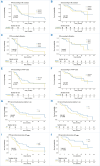LuciA-15 - a real-world prospective study of PARP inhibitors for the treatment of patients with HER-2 negative metastatic breast cancer with germline and/or somatic mutation of BRCA genes or homologous recombination repair related genes
- PMID: 38414929
- PMCID: PMC10898875
- DOI: 10.3332/ecancer.2023.1634
LuciA-15 - a real-world prospective study of PARP inhibitors for the treatment of patients with HER-2 negative metastatic breast cancer with germline and/or somatic mutation of BRCA genes or homologous recombination repair related genes
Abstract
Background: Poly(adenosine diphosphate-ribose) polymerase inhibitors (PARPi) improve progression free survival among patients with HER2 negative (HER2-ve) advanced breast cancer (ABC) and a BRCA1 or BRCA2 mutation compared to chemotherapy (CT). The objective of this prospective study was to evaluate the clinical benefit of PARPi treatment in terms of response, outcomes and survival by breast cancer type and treatment in a Latin-American population.
Methods: From September 2019 to April 2023, we analyzed the data of patients with HER2-ve ABC with germline and/or somatic mutation of BRCA1 or BRCA2, or in the homologous recombination repair genes, treated with olaparib or talazoparib in daily clinical practice by oncologist from Argentina and México. real-world objective response rate (rwORR), best response rate, real-world progression-free survival (rwPFS) and real-world overall survival (rwOS) were analysed with R software and RStudio version 14.0.
Results: After a median follow-up of 18.07 months (95% CI 10.53-30.07), 51 patients were treated with PARPi. Mean age at starting treatment was 47.08 years. 62.7% had ER + ve/HER2-ve and 35.3% had triple negative breast cancer (TNBC). 62.7% and 37.3% of patients received talazoparib and olaparib, respectively. BRCA 1 and 2 germline mutations were the most common alterations found in 96% of patients. 37.5% of patients received platinum-based CT in the (neo)adjuvant/metastatic setting. At the time to starting PARPi treatment, 57.5% had visceral metastasis, the median number of metastatic sites was 2 (range 1-4), the median number of lines was 2 (range 0-8), and 23.5% and 31.4% received PARPi in the 1st line and 2nd line, respectively.The rwORR was 47.0%, and the median real-world progression-free survival-1 (rwPFS1) was 7.77 months (95% CI 5.67-14.7). There was a tendency of better rwPFS1 in patients with versus without previous CT in the advance setting, 6.37 months (95% CI 5.03-8.73) and 14.30 months (95% CI 6.47-NR), respectively (p 0.084). The median rwOS was 26.97 months (95% CI 13.50-NR) and higher in the subgroup of patients naïve for CT versus previous exposure to CT in the advance setting, the median rwOS was 32.1 months (95% CI 27.0-NR) versus 13.0 (95% CI10.1-NR), respectively (p 0.022). The medium real-world progression-free survival-2 (next treatment after PARPi failure) was 4.00 months (95% CI 3.43-7.13). Treatment was discontinued due to adverse events in 4.0% of patients.
Conclusion: This is the first evidence in a Latin-American population that replicates the data already published in randomised clinical trials and other scanty real-world evidence studies in this field, showing positive results in rwORR and rwPFS, and encouraging data in rwOS. Notably, there was a high proportion of patients with visceral progression even with visceral crisis and need for CT. Interestingly, there were similar rwOS results among subgroups (TNBC versus ER + ve/HER2-ve, talazoparib versus olaparib, etc).
© the authors; licensee ecancermedicalscience.
Conflict of interest statement
The authors declare that they have no conflict of interest.
Figures




Similar articles
-
Clinical Actionability of Molecular Targets in Multi-Ethnic Breast Cancer Patients: A Retrospective Single-Institutional Study.Mol Diagn Ther. 2025 May;29(3):393-405. doi: 10.1007/s40291-025-00777-7. Epub 2025 Apr 7. Mol Diagn Ther. 2025. PMID: 40192953 Free PMC article.
-
Cisplatin with veliparib or placebo in metastatic triple-negative breast cancer and BRCA mutation-associated breast cancer (S1416): a randomised, double-blind, placebo-controlled, phase 2 trial.Lancet Oncol. 2023 Feb;24(2):162-174. doi: 10.1016/S1470-2045(22)00739-2. Epub 2023 Jan 6. Lancet Oncol. 2023. PMID: 36623515 Free PMC article. Clinical Trial.
-
Multicenter Real-World Data of Subsequent Chemotherapy after Progression to PARP Inhibitors in a Maintenance Relapse Setting.Cancers (Basel). 2022 Sep 11;14(18):4414. doi: 10.3390/cancers14184414. Cancers (Basel). 2022. PMID: 36139574 Free PMC article.
-
The role of novel poly (ADP-ribose) inhibitors in the treatment of locally advanced and metastatic Her-2/neu negative breast cancer with inherited germline BRCA1/2 mutations. A review of the literature.J Med Life. 2021 Jan-Mar;14(1):17-20. doi: 10.25122/jml-2020-0132. J Med Life. 2021. PMID: 33767780 Free PMC article. Review.
-
Integrating PARP inhibitors into the management of breast cancer: where are we?Chin Clin Oncol. 2021 Jan;10(5):50. doi: 10.21037/cco-19-230. Epub 2020 Dec 31. Chin Clin Oncol. 2021. PMID: 33440946 Review.
References
-
- Robson ME, Tung N, Conte P, et al. OlympiAD final overall survival and tolerability results: olaparib versus chemotherapy treatment of physician's choice in patients with a germline BRCA mutation and HER2-negative metastatic breast cancer. Ann Oncol. 2019;30(4):558–566. doi: 10.1093/annonc/mdz012. - DOI - PMC - PubMed
LinkOut - more resources
Full Text Sources
Research Materials
Miscellaneous
